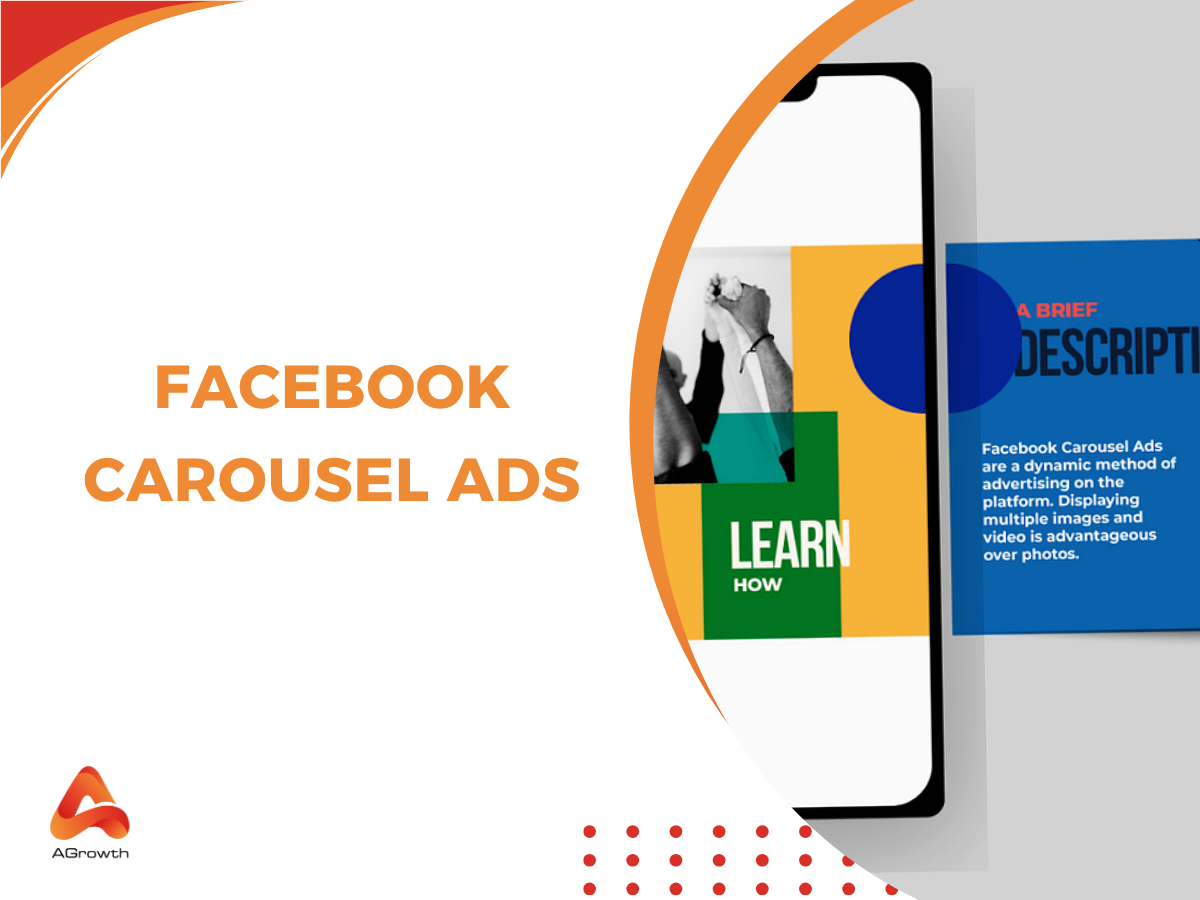
Table of Contents
Facebook Carousel Ads Guide: Specs, Benefits, Optimization & Best Practice
In the fast-evolving world of social media advertising, Facebook carousel ads have remained one of the most engaging and effective ad formats for marketers. Whether you’re an eCommerce brand looking to showcase multiple products or a B2B company aiming to tell a story in steps, carousel ads offer a unique visual storytelling experience that captivates users and drives results.
In this ultimate guide to Facebook carousel ads, we’ll walk you through everything you need to know, including:
- Definition of a Facebook carousel ad
- Official sizing and technical specifications
- Benefits of Facebook carousel ads
- A step-by-step guide to create carousel
- Tips to optimize your Facebook carousel ads.
What Is A Carousel Facebook Ad?
A Facebook carousel ads is an interactive format allowing to showcase up to 10 images or vids within a single advertisement. Each card in the carousel can feature its own caption, description, and call- to- action button, allowing users to swipe through different products, services, or story essentials seamlessly.
To view all your products and services, users simply need to swipe across their screen. This format creates an immersive experience that encourages user interaction and provides more real estate for showcasing your brand’s offerings.

Key Features Of Facebook Carousel Ads
Facebook Carousel Ads offer unique capabilities to help marketers capture attention, increase conversions, and create highly engaging ad experiences. Below are the key features that set carousel ads apart from other ad types on the Meta platform.
Multi-Card Format
A carousel Facebook ad can contain different images or videos, which allows a variety of storytelling techniques to be used in a single ad unit. This flexibility enables brands to showcase product catalogs, demonstrate step-by-step processes, or tell compelling brand stories.
Individual Links per Card
The ability of Facebook carousel advertising to direct viewers to a separate landing page from each card is one of their most powerful capabilities. This means you can tailor each card to a specific product, offer, or funnel stage, drastically improving click relevance.
For campaigns aiming to collect user information, carousel cards can also be linked to lead forms. If you’re running lead generation campaigns, here’s a useful guide on how to download leads from Facebook Ads Manager.
Retargeting and Sequential Storytelling
Because carousel cards can be linked and tracked individually, advertisers can use them for advanced retargeting or narrative-based storytelling.
For example:
- Retarget users who viewed a certain card with a follow-up ad.
- Tell a brand story in a “chapter-style” sequence, with each card representing a key message.
This ability to guide the customer journey in a visual and structured format is what makes carousel ads particularly effective in both direct response and brand campaigns.
Support for Both Images and Videos
Unlike most ad formats that focus on either static images or video, carousel ads allow a mix of both within a single ad. You can combine video cards with still images to create an engaging rhythm, drawing attention and holding it for longer.
If you’re focusing specifically on video content, it’s worth learning more about how to run effective Facebook video ads to complement your carousel strategy.
Benefits Of Using Facebook Carousel Ads
Facebook carousel ads, in contrast to conventional single-image commercials, enables marketers to present several items, tell more in-depth tales, and lead visitors through a structured narrative; all within a single, scrollable ad unit. Let’s explore the key benefits of using this format in detail.
Interactive user experience that boosts engagement
One of the biggest advantages of Facebook carousel ads is the interactive format, which naturally encourages users to swipe or scroll through the cards. This motion-based engagement makes the ad feel more like a mini-experience. When users are invited to explore content rather than passively consume it, they’re more likely to pay attention and that engagement is crucial for both brand recall and conversion.
Improved Click-Through Rates (CTR)
Performance marketers consistently report higher click-through rates with carousel ads than with single-image or even video-only formats. The ability to present multiple products or messages within a single ad means more chances to connect with a user’s interest. For example, if a viewer isn’t interested in the first card, they might find something compelling in the second or third.
In many case studies, carousel ads have outperformed static ads by up to 30% or more in Facebook CTR, simply because they provide more content without overwhelming the user.
Enhanced product showcase
Facebook carousel ads are ideal for ecommerce stores or product-based businesses, as they allow you to display up to 10 different products, services, or features within a single ad unit. This can dramatically reduce your ad spend by consolidating what would typically require multiple campaigns into one cohesive format.
Each carousel card can link to a separate product page, making it easier for users to navigate directly to the item they’re most interested in. This multi-link functionality not only enhances user navigation but also increases the chances of a purchase, as the customer journey becomes smoother and more relevant.
Stronger storytelling capabilities
Brands that want to tell a story whether it’s about their values, their customer journey, or how their product works can benefit immensely from carousel ads. The sequential card format allows marketers to break down a message into digestible chunks and walk users through it step by step.
Moreover, some brands use carousel ads to create panoramic visuals, where the full impact is only revealed as the user swipes through. This adds an element of intrigue and delight, further increasing engagement.
Higher Return on Ad Spend (ROAS)
Because of their interactive nature, multi-product capability, and improved CTR, Facebook carousel ads often deliver a better return on ad spend (ROAS) than traditional formats. Advertisers can consolidate multiple offers or messages into one placement, reducing the need for several separate ad campaigns.
In industries like fashion, home décor, and electronics, carousel Facebook ads have been shown to lower cost-per-click (CPC) and cost-per-conversion, while increasing both sales volume and average order value. This makes them a cost-effective tool for businesses that want to stretch their ad budgets while still achieving strong performance.

Facebook Carousel Ads Specs And Sizes
Understanding the technical specifications for Facebook carousel ads is crucial for creating visually appealing and properly displayed advertisements.
Image
For the most optimized ad performance, it’s recommended:
- Minimum Image size: 1080 x 1080 pixels
- Maximum File size: 30 MB per image
- Aspect ratio: 1:1 (square) is most commonly used or 4:5
- Image format: JPG or PNG files are accepted.
- Maximum image file size: 30 MB
Video
Regardings video Facebook carousel, it’s recommended:
- Maximum file size: 4 GB per video
- Video length: Up to 240 minutes (though shorter videos typically perform better)
- Aspect Ratio: 1:1(most recommended) to 16:9
- Resolution: Minimum 720p, with 1080p recommended.
How To Create A Facebook Carousel Ads
Creating effective Facebook carousel ads requires careful planning and execution. Follow this guide to set up your carousel campaign effectively.
Step 1: Access Meta Ads Manager
First, log in to the Meta Ads Manager account. To start a new campaign, navigate to the Ads Manager dashboard and click the “Create” button.

Step 2: Choose your campaign objective
Select the campaign objective that aligns with your marketing goals. Carousel ads work well with various objectives, such as traffic, awareness, engagement, leads, app promotion, or sales.

Step 3: Define audience, placements, and budget
At the Ad Set level, configure the following:
- Audience Targeting: Use saved audiences, custom audiences, or lookalike audiences depending on your strategy.
- Placements: You can allow Meta to auto-select placements (“Advantage+ placements”) or manually select platforms like Facebook News Feed, Instagram Feed, Stories, etc.
- Budget & Schedule: Set your daily or lifetime budget and select your campaign start and end dates.
Step 4: Choose the carousel format
At the Ad level, go to the “Format” section and select “Carousel”. This will enable you to upload multiple images or videos, each acting as a scrollable card.
You’ll be prompted to either:
- Manually upload each card, or
- Use Dynamic Creative or a Product Catalog to automatically populate content from your inventory.
Step 5: Upload Creative for each card
Now you can begin populating the carousel cards. For each card:
- Upload an image or video (recommended size: 1080×1080 pixels; 1:1 ratio)
- Add a headline and description
- Insert a strong CTA button (e.g., “Shop Now”, “Learn More”, “Sign Up”)
- Set a unique destination URL for each card
You can add up to 10 cards. If your ad follows a narrative, disable the “Automatically show best performing cards first” option to preserve the story order. Otherwise, leaving this option on can help Facebook optimize performance dynamically.

Step 6: Add Primary Text, Headline, and Call to Action
Above the carousel cards, add your primary text: this is the main message that appears above your ad. Keep it short, attractive, and relevant to the content in the cards.
Select a headline and a CTA button for the entire ad, though you can also customize these per card.
Step 7: Preview and Test Your Ad
Before publishing, use the ad preview tool to check how your carousel ad will appear across different placements (mobile feed, desktop feed, Instagram, Stories, etc.).
Step 8: Publish Your Ad
Once you’re satisfied with the setup, click “Publish” and your carousel ad will be submitted for review. If approved, it will begin running based on the budget and schedule you selected.
Monitor performance regularly through Ads Manager and be ready to tweak card order, creatives, or targeting based on results.
How To Optimize Facebook Carousel Ads
The real power of this Facebook carousel ads comes from ongoing optimization; refining visuals, copy, targeting, and structure based on performance data. With the right optimization strategies, carousel ads can drive higher engagement rates, lower cost-per-click (CPC), and greater return on ad spend (ROAS).
Start with a strong first card
The first card in a carousel ad functions like a storefront window; it determines whether a user will swipe through the rest or scroll past. This means your hook must be immediate and compelling.
Optimization tips for the first card:
- Use bold, clear visuals with minimal distractions.
- Incorporate emotional triggers or curiosity-driven messages.
- Highlight your best-selling product, a discount offer, or an eye-catching motion graphic.
- Use video or animation if possible, especially for mobile placements.
Leverage Facebook’s Auto-Optimization Feature
Facebook’s carousel ads include an option to automatically display the best-performing cards first. This helps maximize engagement and CTR by putting your most effective content front and center.
Use this when:
- You’re not telling a sequential story.
- You want Facebook’s algorithm to dynamically optimize which cards convert best.
Turn it off when:
You’re narrating a product walkthrough, tutorial, or brand story where card order matters.
A/B test everything – card by card
A key advantage of Facebook carousel ads is the ability to test multiple visuals, headlines, and landing pages within one ad unit. However, you should still split-test entire versions of carousel ads to see what structure performs best.
What to test:
- Number of cards (e.g., 3 vs. 5 vs. 7)
- Static images vs. video thumbnails
- Headline variations across cards
- CTA buttons (e.g., “Shop Now” vs. “See More”)
- Card order (for storytelling formats).
Use High-Quality, Consistent Visuals
Visual consistency across cards improves swipe-through rates by giving users a smoother, more branded experience. Mismatched or poorly lit images can cause visual friction, lowering engagement.
Best practices for creative consistency:
- Stick to a single color palette or tone.
- Use the same background or setting across all cards.
- Maintain similar image framing (e.g., all product shots at same distance).
- Use branded fonts and logo placements in the same location on each card.
Tailor links and CTAs per card
One of the most underutilized optimization tactics is customizing the CTA and landing page for each card. Rather than linking every card to the homepage or a generic page, lead users directly to the product, service, or stage most relevant to the card they clicked.
Optimize for mobile viewers first
Over 90% of Facebook’s ad engagement happens on mobile devices. If your carousel ads aren’t designed with mobile in mind, you’re leaving performance (and revenue) on the table.
Mobile-specific optimization strategies:
- Use large, legible text (minimum 16pt font size).
- Avoid clutter: minimalist design performs better on small screens.
- Ensure buttons and clickable elements are easily tappable.
- Test image cropping: make sure key visual elements aren’t cut off in mobile previews.
Analyze per-card performance and rotate out underperformers
Meta Ads Manager gives you access to detailed insights for each carousel card; including impressions, clicks, CTR, and conversion data. Use this data to identify which cards are resonating and which are underperforming.
Optimization actions based on analysis:
- Remove or replace low-performing cards to streamline the experience.
- Duplicate top-performing cards with slight variations (e.g., new headline).
- Adjust card order for strong performers appearing first in the sequence.
Doing this regularly will keep your ad fresh and relevant, extending its lifespan and improving ROI.
FAQs
Is Carousel still available on Facebook?
Yes, Facebook Carousel Ads is still fully available and supported in 2025. This format continues to be a popular choice for advertisers who want to showcase multiple products, tell stories, or drive higher engagement through interactive scrolling.
Are Facebook carousel ads more expensive?
Not really. Facebook carousel ads are not inherently more expensive than single-image or Facebook video ads. The cost of any Facebook ad is influenced by several factors, including:
- Your bidding strategy and budget
- Audience targeting and competition
- Ad quality and engagement level
- Industry (e.g., ecommerce vs B2B)
How much do Facebook carousel ads cost?
There is no fixed cost for carousel ads, as pricing is determined by Meta’s ad auction system. However, typical benchmarks are:
- Cost-per-click (CPC): $0.50 – $2.00 (depending on industry and audience)
- Cost-per-thousand impressions (CPM): About $5 – $15
-
Cost-per-conversion: Varies based on product price and funnel
Carousel ads can often reduce overall customer acquisition cost by showcasing multiple offers or entry points within a single ad—making them more efficient than running several individual ads.
How do Facebook carousel ads differ from collection ads on Facebook?
Carousel ads let users swipe through multiple images or videos, each with its own link. Collection ads feature a cover image or video followed by a product grid, and open a full-screen shopping experience on mobile. Carousel is better for storytelling or showcasing multiple products; collection is ideal for seamless mobile shopping.
Final thoughts
Facebook carousel ads are a powerful format that blend visual storytelling, multiple product showcases, and higher engagement in one interactive experience. With proper specs compliance, creative design, and ongoing optimization, they consistently deliver superior CTR, conversions, and ROI.










Your comment